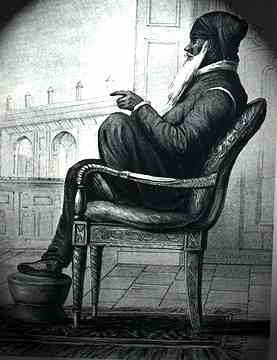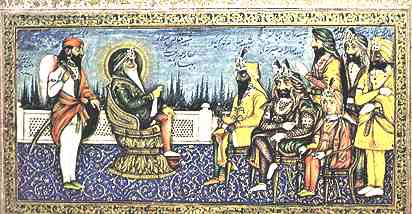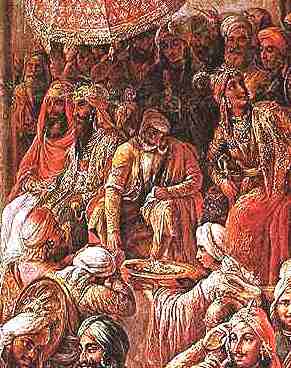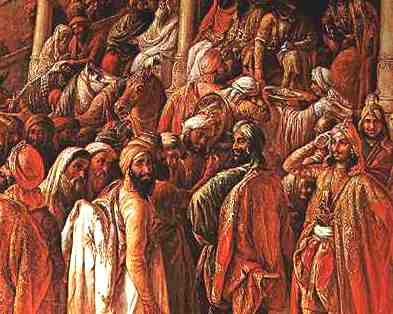|
|
|
|
|
|
|
|
|
|
|
|
|
|
|
|
|
|
|
|
| Menu |
|
|
|
|
|
|
|
|
|
|
|
|
|
|
|
|
|
Sher-e-Punjab
Maharaja Ranjit
Singh |
|
|
|
|
|
|
|
|
|
|
|
|
|
Maharaja Ranjit Singh was born on the 2nd of November 1870, to the chief
of the 'ShukerchakiyaMissal', Sardar Mahan Singh and his wife Mata Raj Kaur.
An attack of small pox in his young age robbed him of the use of his left
eye.
He was only ten when his father died, and his mother put him under the charge
of Sardar Dal Singh and Diwan Lakhpat Rai, who taught him the everyday running
of the estate. Bhai Feru Singh, the granthi of the Gujranwala Gurdwara, taught
him Gurmukhi and Gurbani. The young Ranjeet was keener as a horse rider and
the use of weaponry, which eventually became the most prominent features in
his life. |
|
|
|
|
|
 |
|
|
|
|
|
|
|
|
|
 |
|
|
|
|
|
|
|
|
|
|
|
|
|
Maharaja
Ranjit Singh with family members and courtiers. |
|
|
|
|
|
|
|
|
It
was his audacity and ambition that made him conquer Lahore in 1799, and soon
after that he was declared the "Maharaja", but he preferred the title of "Singh
Sahib" to the title of 'Maharaja'. He became such a majestic king, that in a
very short period he conquered all the nearby regions and his kingdom flourished
from the Satluj to the borders of Sindh and Tibet, including Peshawar, Kashmir
and Multan. His plan was to unite the twelve Sikh 'Missals' and create a united
Sikh Empire, which he managed during his victorious life span. Such expansion
built up his personal prestige. The more battles he won, and the more territory
he acquired, the greater became his name. Yet, alongside ruthless daring went
cunning prudence and perhaps his greatest success was the containment of the
British. While the Sikh Missals had been battling in the 18th century, the British
had been steadily moving north. In 1803 they took Delhi and in 1805 routed the
Marathas. Since Mughal rule was over, no other power rivalled them. But to the
north lay Afghanistan, Persia and Russia with the Punjab in-between. It was
vital to their safety to secure northern India: but the means of doing so was
far from clear. Should they fight the Sikhs, annex the Punjab, invade Afghanistan?
Or should they pause and negotiate? Ranjit Singh's skill and brilliance made
them choose peace. In 1809 he sought to subdue the six Sikh Missals south of
the River Satluj. The British objected and occupied Patiala. Then instead, of
declaring war, they signed a treaty on the 25th of April 1809 By this agreement,
both the Maharaja and the British accepted the Satluj as a permanent boundary
between them that sealed the friendship of these two ruling powers. Although
they promised 'perpetual friendship' but neither side entirely trusted the other,
only necessity kept them at peace. |
|
 |
|
|
|
|
|
|
|
|
|
|
|
|
|
The Lahore Durbar.
The Maharaja with his son Kharak Singh, grandson
Naunihal Singh, Udham Singh, Gulab Singh, Bhai Ram Singh and his bodyguards. |
|
|
|
Amongst the foreign historians he was known as "the Lion of Punjab" - "Shere
Punjab". Foreign journalists and warriors, for whom he had the greatest of
respect, always adorned his Darbar (court). His army had great respect and
admiration for him, and was always ready to give their lives for him and the
Sikh Empire.
In forming the Sikh Empire, the Maharaja was assisted over the years by
quite a number of able assistants. These engineers of success can be divided
into four groups. In his early years he owed much to Maharani Sada Kaur, his
firm mother-in-law. He also acted, at this time, through and with his fellow
Sikhs. Yet soon he sensed that in a world of vehement rivalries and inter-missal
conflicts, his best counsellors were non-Sikhs. Only men with no exterior
allegiances, whose entire position, status and career depended on himself,
could be fully trusted. He therefore discarded Sikh confidants and recruited
instead an inner council of outsiders. The Brahmin Dina Nath, an expert in
taxation, organised his finances. Aziz-ud-Deen, a young Muslim physician whose
intelligence and sympathy had won his confidence, became Foreign Minister.
Khushala, a Brahmin from Meerut, who had joined Ranjit's bodyguard and fired
him with his personal attractions, became his intimate favourite, adopted
Sikhism and was known as Jamadar Khushal Singh. From 1811 until 1818 he swayed
the household as Lord Chamberlain, determining who should have access to the
Maharaja and on what terms. Although he was later seconded to the army, he
was never wholly superseded. |
|
 |
|
|
|
|
|
|
|
|
|
|
|
At
the court of Lahore. Suchet Singh (in green), Dhian Singh (4th left), Hira Singh
(extreme right), Tej Singh, Labh Singh, Lal Singh, Dina Nath & Fakir Azizuddin
(2nd from left) |
|
|
|
But it was rather a
third group, three Dogra brothers, who attracted public attention and gave
panache to Ranjit's court. Jn 1810, a young member of the Jammu junior line,
a Dogra Rajput named Gulab Singh, had entered Ranjit's army. A little later
two handsome brothers, Dhian Singh and Suchet Singh joined him. Fascinated
above all by the polished Dhian, Ranjit made him first a porter in the palace,
then, in 1818, chamberlain or lord of the privy chamber and finally in 1828
Chief Minister. In this capacity Dhian Singh amassed wealth, became master
of a great tract on the borders of Kashmir and maintained an army of 25,000
men His young son, Hira, became Ranjit's inseparable companion, even sitting
in a chair beside him, while his own father deferentially stood. Dhian's
appointment led to the promotion of his two brothers - Suchet, who hovered
around the court as a 'gay courtier and gallant soldier', and Gulab Singh,
the most enterprising of the three. He usually remained in the Hills, but
from time to time visited the court. In 1820 he was made Raja of Jammu,
replacing the senior line and holding the state in semi-independent charge.
Eventually he was to become the most powerful of all Ranjit Singh's associates. |
|
|
|
|
|
|
|
|
|
|
|
|
|
|
|
Next |
|
|
|
 |
 |
 |
 |
 |
 |
 |
 |
 |
 |
 |
 |
 |
 |
 |
 |
 |
 |
 |
 |



